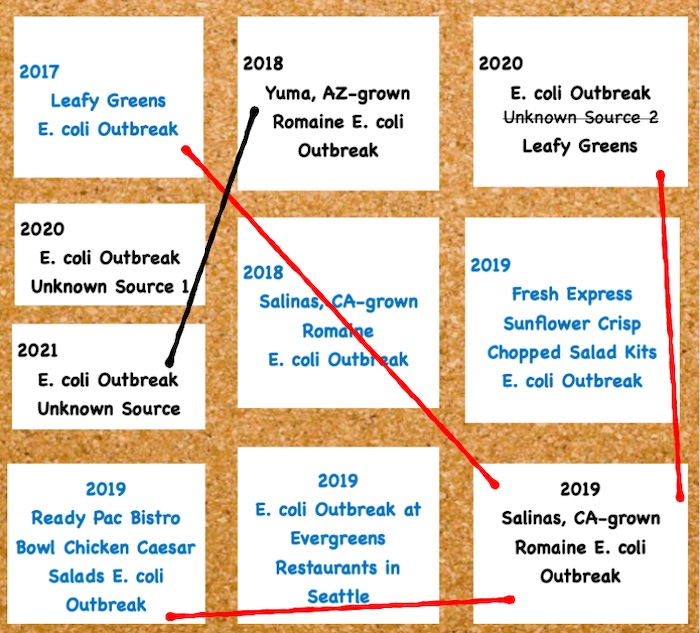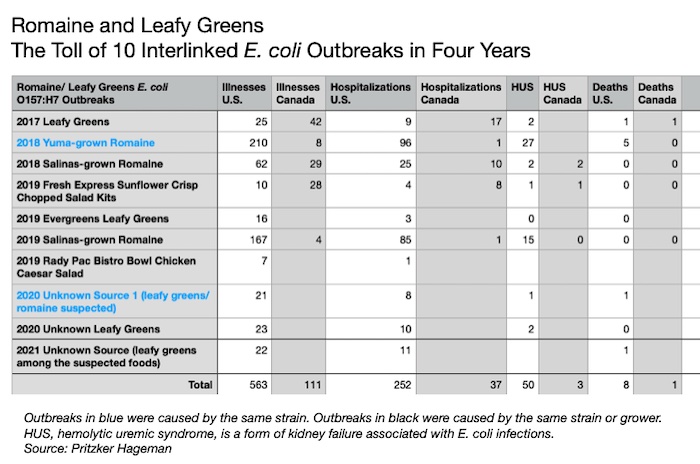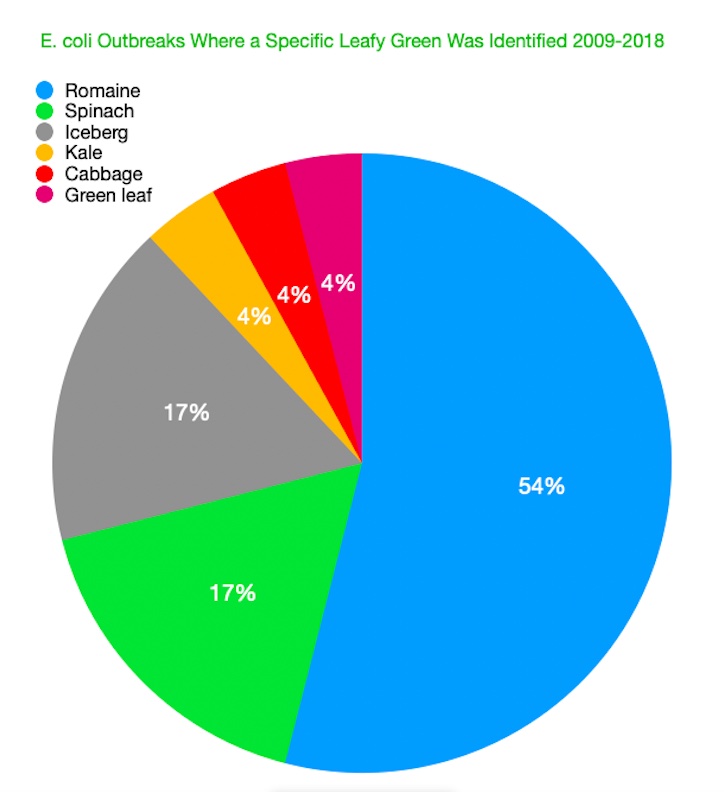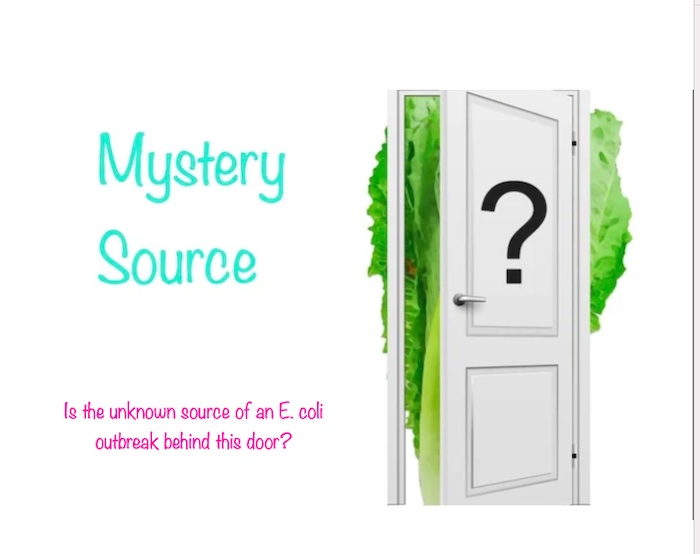Health officials in Washington say some kind of fresh produce is the source of an E. coli O157:H7 outbreak that includes six confirmed and at least as many probable cases. Previous E. coli outbreaks have been linked to cilantro, sprouts, green beans, guacamole and strawberries, according to the Centers for Disease Control and Prevention (CDC). But looking over the agency’s outbreak data, one type of produce eclipses all others, leafy greens. Specifically romaine lettuce.
Contact the Pritzker Hageman E. coli Lawyers Today
Phone: 888-377-8900 | Text: 612-261-0856
Contact our E. coli Food Safety Lawyers Online
E. coli outbreaks linked to romaine lettuce and other leafy greens have dominated food safety headlines in recent years. Since 2017, 10 such E. coli outbreaks have been linked to either the same E. coli strain, the same romaine lettuce grower, or both.
These interlinked outbreaks, all associated with leafy greens grown in Salinas, CA or Yuma, AZ, resulted in 674 illnesses, 289 hospitalizations, 53 cases of hemolytic uremic syndrome (HUS), a form of kidney failure; and nine deaths in the U.S. and Canada.
But the recent onslaught of these outbreaks doesn’t mean E. coli and leafy greens are a new combination. Since 2006, just two types of produce have been identified as the source of multistate E. coli outbreaks announced by the CDC – sprouts and leafy greens. And leafy greens outnumber the sprouts 3-1.
In fact, leafy greens are actually the second-most common source of all E. coli outbreaks. (Ground beef holds the top spot.) And romaine is the source of more than half of all E. coli outbreaks linked to leafy greens, according to a recent study of 40 E. coli outbreaks linked to leafy greens. Spinach, iceberg, cabbage, green leaf lettuce and kale were identified as the sources of the remainder of those outbreaks.
E. coli O157:H7 and HUS
Many strains of E. coli exist in nature and are harmless. But E. coli O157:H7, which almost exclusively lives in the intestines of cattle, causes severe illness because it produces a substance that is poison to humans called a Shiga toxin.
Symptoms of these infections usually develop within three to five days of eating contaminated food and include severe abdominal cramps and diarrhea that can be bloody. HUS affects between 5 percent and 10 percent of E. coli patients. This condition, which can cause kidney failure, seizure, stroke, coma and death, usually develops one week after initial E.coli symptoms. HUS symptoms include pale skin, fatigue, unexplained weakness and bruising, decreased urination, fainting, and bloody diarrhea. Anyone with HUS symptoms should seek immediate, emergency medical care.
Washington E. coli Outbreak
The E. coli O157:H7 outbreak in Washington began in King County but has expanded to three other counties in two different parts of the state. The state department of health has taken over the investigation of the outbreak and is only including cases confirmed to be linked to one another through genetic testing of the E. coli cultured from people who got sick. Some tests are still underway. The counties with confirmed cases so far are Benton (1) King (3), Snohomish (1), and Walla Walla (1).
Three people have been hospitalized, two of them with HUS. They reported onset of illness dates ranging from March 9 to April 21, 2021. The age groups of the patients are as follows: one patient is between the ages of 0-9, two are between the ages of 10-19, one is 20-29, one is 30-39, and one is in the 70-79 age group.
Before the state health department took over the investigation, King County had reported seven illnesses, all among children 14 and under. Six of these children were hospitalized, two with HUS. They reported onset of illness dates ranging from April 17 – April 29, 2021. And Snohomish County had reported two illnesses from separate households, a woman in her 20s and a child under the age of 10. The child was hospitalized. Snohomish County did not provide onset of illness dates.
Springtime Romaine E. coli Outbreaks
Since 2006, just two of the multistate E. coli outbreaks linked to romaine lettuce or leafy greens have occurred in the spring. One, in 2010, was an E. coli O145 outbreak linked to shredded romaine lettuce from a single processing facility. That outbreak was announced on April 16, 2010, by Michigan health authorities after they discovered a cluster of 11 E. coli illnesses in that state. Eventually, the outbreak would expand to include 26 confirmed and seven probable cases in four other states, New York, Ohio, Pennsylvania and Tennessee. Twelve people were hospitalized, three had HUS.
The other springtime E. coli outbreak was the infamous 2018 E. coli O157:H7 outbreak linked to romaine lettuce grown in Yuma, AZ. The people sickened in the outbreak reported onset of symptoms on dates ranging from March 13, to June 6, 2018. The 36-state outbreak sickened 210 people, almost half of whom were hospitalized. Twenty-seven people developed HUS. Five people died.
The U.S. Food and Drug Administration (FDA) conducted a “traceback” investigation of the outbreak to determine its source. But the agency could not narrow it down to a single grower, processor or distributor, only the implicated growing region, Yuma, where 90 percent of the nation’s romaine is grown at that time of year.
The FDA would later say three things complicated ts investigation. One, April is the end of Yuma growing season and there were no more crops in the fields to test. Two, the romaine products sold to stores and restaurants contained lettuce from various farms. And, three, many of the records were handwritten.
Experienced E. coli Lawyers
Despite lots of industry and regulatory analysis not much has changed since the Yuma outbreak. Growers, balking at the expense, have resisted automation of records and post-harvest testing. When outbreaks occur, it is usually near the end of the growing season in California or Arizona. Like it is now. And brand names of implicated products or restaurants that served them are rarely released. This puts consumers at risk and prevents them from spurring change through informed purchasing decisions.
At Pritzker Hageman, we’ve seen all this up close. Too close. We have represented clients in every major E. coli outbreak in the U.S. Our clients have included those who battled HUS and families who have suffered the wrongful death of a loved one. If you were sickened in this outbreak and would like a free consultation with an experienced E. coli lawyer, please contact the Pritzker Hageman E. coli Legal Team. You can reach us by calling 1-888-377-8900, sending a text to 612-261-0856, or by completing the form below. There is no obligation and you don’t pay us unless we win.



